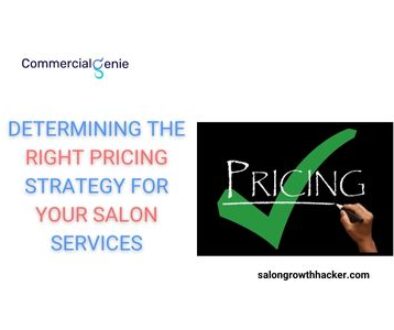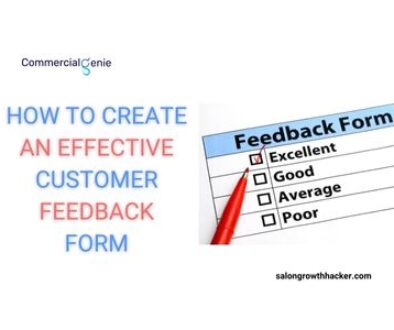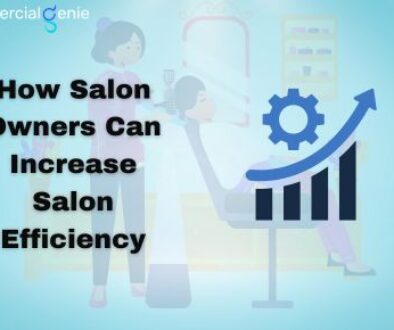Mobile Optimization 101 For Your Salon: The Need For A Mobile Responsive Website
Introduction
Mobile devices have become an essential part of our life in the current digital era. People rely on smartphones and tablets for various tasks, including searching for local businesses like salons. Ensuring your website is mobile responsive as a salon owner is crucial to provide your potential customers with a seamless and engaging experience. In this blog, we will explore the importance of mobile optimisation for your salon’s website and provide valuable insights on how to make your website mobile responsive.
Understanding the Importance of Mobile Optimization

a. The Rising Popularity of Mobile Browsing
In recent years, mobile browsing has experienced a significant surge in popularity. With the increasing accessibility of smartphones and tablets, more and more people are using their mobile devices to browse the internet. This shift in consumer behaviour means that many of your target audience access your salon’s website through mobile devices. By optimising your website for mobile, you can ensure that your content is easily accessible and visually appealing on smaller screens, capturing the attention of mobile users and increasing the likelihood of conversions.
b. Improved User Experience
The user experience greatly influences the success of your website. Visitors who access your salon’s website on their mobile devices expect a seamless and intuitive browsing experience. A mobile-responsive website adjusts its layout and design elements to fit different screen sizes, providing users with a consistent and optimised experience across devices. By delivering a user-friendly mobile experience, you can keep visitors engaged, reduce bounce rates, and increase the chances of them exploring your salon’s offerings or making a booking.
c. Enhanced Search Engine Rankings
Websites responsive to mobile devices are prioritised in search results on search engines like Google. With the increasing emphasis on mobile optimisation, having a mobile-responsive website can positively impact your search engine rankings. Search engines recognise the importance of delivering relevant and high-quality results to mobile users, and they prefer websites that provide an optimal mobile experience. By optimising your website for mobile, you improve its chances of ranking higher in mobile search results, driving more organic traffic to your salon’s website.
The Benefits of a Mobile Responsive Website

a. Consistent User Experience Across Devices
One of the key benefits of a mobile-responsive website is that it provides a consistent user experience across different devices. Whether visitors access your website from a desktop computer, smartphone, or tablet, they will have a seamless and visually appealing experience. Consistency in design, navigation, and functionality across devices enhances user satisfaction and helps build trust and credibility for your salon.
b. Increased Mobile Traffic and Conversions
Having a mobile-responsive website opens up opportunities to attract and capture mobile traffic. As more people rely on their mobile devices for online activities, including searching for salon services, a mobile-friendly website increases your visibility and reach among mobile users. By providing a smooth and engaging browsing experience, you can convert mobile visitors into loyal customers, increasing conversions and revenue for your salon.
c. Competitive Advantage in Local Search
Local search is vital for salon businesses as many potential customers search for nearby salons on their mobile devices. A mobile-responsive website gives you a competitive advantage in local search results. Search engines consider mobile-friendliness as a ranking factor for local searches, and having a mobile-responsive website increases your chances of appearing prominently in local search listings. This visibility can help you attract local customers actively seeking salon services, giving you an edge over competitors with non-responsive websites.
d. Improved Loading Speed and Performance
When it comes to website loading times, mobile consumers have high standards. A mobile-responsive website is optimised for faster loading times on mobile devices, providing a smooth and enjoyable browsing experience. Fast-loading websites not only enhance user satisfaction but also reduce bounce rates. Visitors are more likely to explore your salon’s website, browse through services, and make bookings when not frustrated by slow loading times. Additionally, improved loading speed can positively impact your search engine rankings, as search engines prioritise websites with faster performance.
Best Practices for Mobile Optimization

a. Responsive Web Design
One of the key best practices for mobile optimisation is implementing responsive web design. Responsive design ensures your website adapts and scales seamlessly across different screen sizes and devices. This approach eliminates the need for separate mobile and desktop versions of your site, providing a consistent user experience. With responsive design, your website’s layout, images, and content automatically adjust to fit the user’s screen, ensuring optimal viewing and interaction on mobile devices.
b. Optimize Page Speed for Mobile
Page speed is crucial for mobile optimisation. Mobile users have shorter attention spans and expect fast-loading websites. Optimise your salon’s website for mobile by minimising code and file sizes, leveraging browser caching, and compressing images. Additionally, consider using content delivery networks (CDNs) to deliver content quickly to users across different geographical locations. Improving your website’s page speed enhances user experience, reduces bounce rates, and improves search engine rankings.
c. Simplify Navigation and Design for Small Screens
Mobile users typically interact with websites using touch gestures on smaller screens. To optimise your website for mobile, simplify navigation and design elements. Use clear and easily clickable buttons, minimise the number of menu items, and prioritise essential information. Consider using a hamburger menu for mobile devices to save screen space. Ensure your salon’s website is easy to navigate and intuitive, allowing users to find information and services quickly.
d. Use Mobile-Friendly Content and Images
Ensure that your website’s content and images are optimised for mobile viewing. Mobile-friendly content should be concise, scannable, and easily readable on smaller screens. Break up text into shorter paragraphs, use bullet points, and incorporate headers to improve readability. Optimise images by resizing and compressing them to reduce load times without compromising quality. Additionally, consider using responsive images that adjust based on the user’s device and screen resolution.
Mobile SEO Tips for Salon Websites

a. Optimize for Local Search
As a salon, local search is essential for attracting nearby customers. Optimise your website for local search by including location-specific keywords in your page titles, meta descriptions, and content. Create location-specific landing pages and ensure that your salon’s name, address, and phone number (NAP) are consistent across your website and online directories. Additionally, claim and optimise your Google My Business listing to improve your visibility in local search results.
b. Utilize Mobile-Friendly Keywords
When conducting keyword research for your salon’s website, prioritise mobile-friendly keywords. Mobile search queries often have a different intent and phrasing than desktop searches. Consider long-tail keywords, question-based queries, and location-specific keywords that mobile users will likely use. Incorporate these keywords into your website’s content, headings, and meta tags to increase your visibility in mobile search results.
c. Implement Structured Data Markup
Structured data markup helps search engines understand and display your website’s information more effectively. Implement structured data markup, such as Schema.org markup, to provide additional context to search engines about your salon, services, prices, and customer reviews. This can improve your website’s appearance in search results, especially in mobile snippets and rich effects, increasing your click-through rates.
d. Leverage Social Media for Mobile Engagement
Mobile devices are mainly used to access social media platforms. Leverage the power of social media to engage with your mobile audience. Share compelling content, images, and videos about your salon’s services. Encourage user-generated content and reviews to enhance your social proof. Engage with your followers, respond to comments, and provide customer support through social media channels. By actively participating in social media, you can drive mobile traffic to your website and increase conversions.
Tools and Resources for Mobile Optimization

a. Mobile-Friendly Testing Tools
To ensure your salon’s website is mobile-friendly, you can utilise various testing tools that analyse your site’s responsiveness and performance on mobile devices. These tools provide valuable insights into areas that require improvement and help you identify issues that may affect user experience. Popular mobile-friendly testing tools include:
Bing Mobile Friendliness Test: Similar to Google’s tool, Bing’s Mobile Friendliness Test helps you assess your website’s mobile compatibility. It provides a detailed analysis of potential issues and offers suggestions to enhance your site’s mobile experience.
b. Google’s Mobile-Friendly Test
Google’s Mobile-Friendly Test is essential for assessing your website’s mobile optimisation. It evaluates viewport configuration, font readability, and touch elements’ spacing to determine if your site provides a positive mobile experience. The test generates a detailed report highlighting areas that need improvement and offers recommendations to enhance your site’s mobile responsiveness.
c. Mobile Optimization Guides and Tutorials
Various guides and tutorials are available online to help you understand the intricacies of mobile optimisation and implement best practices. These resources provide step-by-step instructions, tips, and strategies to enhance your site’s mobile performance. Some valuable resources include:
Google’s Mobile SEO Guide: Google offers a comprehensive guide that covers the fundamentals of mobile optimisation. It provides insights into mobile-friendly design principles, page speed optimisation, and mobile SEO best practices.
Moz Mobile Optimization Guide: Moz’s guide to mobile optimisation offers practical advice and techniques to improve your website’s mobile user experience. It covers mobile design, site speed optimisation, and mobile SEO strategies.
Webmaster Forums and Communities: Engaging with webmaster forums and online communities can provide valuable insights and advice from experts and professionals. Platforms like Stack Overflow, Google Webmaster Central Help Forum, and Moz Community offer opportunities to ask questions, seek guidance, and learn from others’ experiences.
Using these tools and resources, you can assess your salon’s website’s mobile-friendliness, implement necessary optimisations, and stay up-to-date with the latest mobile optimisation trends and techniques. Mobile optimisation is an ongoing process, and regularly testing and refining your mobile strategy will ensure a seamless and engaging user experience for your mobile audience.
Conclusion
In conclusion, mobile optimisation is no longer an option but is necessary for your salon’s website. With the increasing popularity of mobile browsing and the importance of user experience, having a mobile-responsive website is essential to drive conversions and stay competitive in the online market.
We discussed the importance of mobile optimisation, including the rising popularity of mobile browsing, improved user experience, and enhanced search engine rankings. We also explored the benefits of a mobile-responsive website, such as consistent user experience across devices, increased mobile traffic and conversions, competitive advantage in local search, and improved loading speed and performance.
To ensure effective mobile optimisation, we explored best practices such as responsive web design, optimising page speed, simplifying navigation and design for small screens, and using mobile-friendly content and images. Additionally, we provided mobile SEO tips tailored to salon websites, including optimising for local search, utilising mobile-friendly keywords, implementing structured data markup, and leveraging social media for mobile engagement.
Lastly, we highlighted valuable tools and resources to assist you in your mobile optimisation efforts, including mobile-friendly testing tools like Google’s Mobile-Friendly Test and Bing Mobile Friendliness Test and mobile optimisation guides and tutorials provided by Google, Moz, and webmaster forums and communities.





